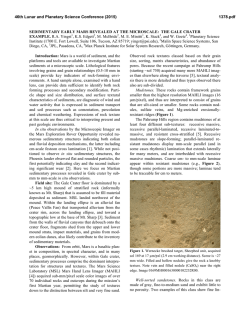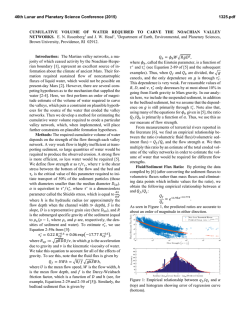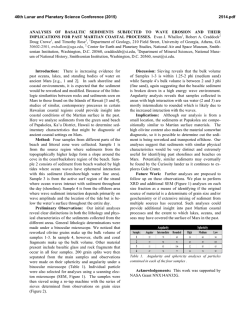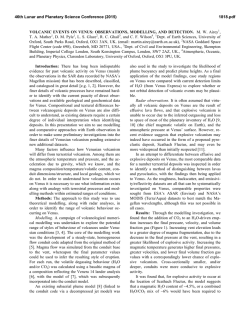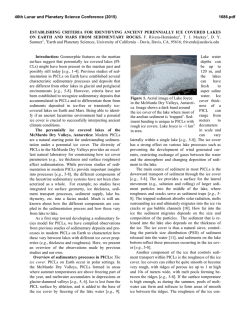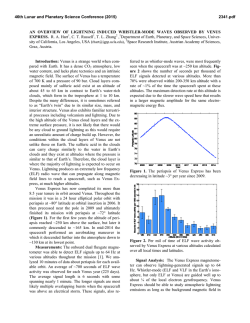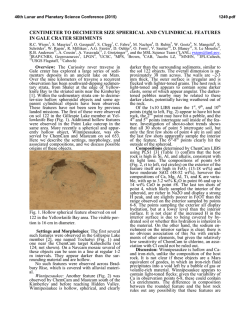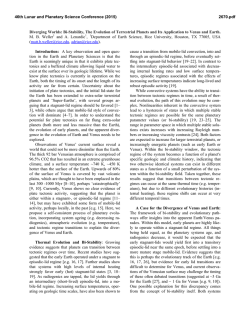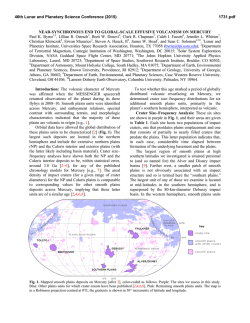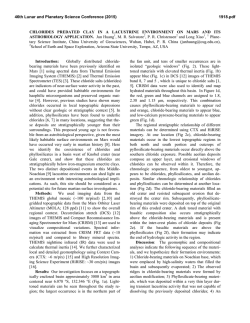
Sedimentary Processes on Venus Imply Rapid Lithification in the
46th Lunar and Planetary Science Conference (2015) 1332.pdf SEDIMENTARY PROCESSES ON VENUS IMPLY RAPID LITHIFICATION IN THE PLAINS. R. C. Ghail1, 1Civil and Environmental Engineering, Imperial College London, London SW7 2AZ, United Kingdom. [email protected] Introduction: Venera lander images most closely resemble sedimentary material, with layered strata (which may be pyroclastic in origin) sometimes broken into cobbles and fine grained sediment. The Magellan SAR reveal a range of weathering processes, particularly at higher elevations, and mass wasting of steep slopes. Mean wind speeds are strongly altitude dependant and are able to erode and transport material throughout the highland regions. This material is deposited on plains where, under the extreme Venus surface conditions, lithification is an apparently rapid process so that the largely featureless plains may not be igneous at all but sedimentary in origin. The settling out and lithification of sedimentary material is consistent with observed crater degradation, in which lowlying crater floors are infilled first. These detailed observations reveal a much more complex and active geological picture, with evidence for a complete sedimentary cycle and significant exchange of materials, particularly volatiles, between the interior and atmosphere, as evidenced by Venus Express. A Sedimentary Landscape: Ten spacecraft, all Soviet, have successfully operated on the Venus surface, including the first ever successful landing on another planet. With the possible exception of Venera 8, the X-ray fluorescence and γ-ray spectrometry data obtained by a number of these landers were all interpreted to indicate weathered basalts [1], consistent with the extensive volcanism evident in Magellan imagery. However, the four landers to successfully return surface images, Veneras 9, 10, 13 and 14, show little in common with basaltic flows on other planets. The bedrock recorded at the Venera 10, 13 and 14 sites consists of laminated or thinly bedded sheets with varying degrees of coarse sediment or regolith. The 5 cm distance between notches on the lander rings of Venera 13 and 14 give an indication of scale [2]. Although chemically similar to basalts, there is no evidence for any features typical of basaltic lava flows such as pillows, rubble, and levées or other channel features. The Venera 14 image, which recorded the lowest sediment fraction, shows that the bedrock consists of a series of interlocked subangular to subrounded plates, possibly jointed. [3] describe the Venera 14 layers as sedimentary bedding, or possibly of basaltic volcanic tuffs, formed by cycles of air fall or ground flow. These same features are apparent in the bedrock component Venera 10 and 13 images. Venera 9 rec- orded rock material similar in appearance to the bedrock elsewhere but in the form of subangular boulders up to 60 cm wide and 20 cm tall, within a coarse sediment or gravel on a ~30 slope interpreted as talus [2]. The gravels are subangular to subrounded and apparently well graded down to the resolution limits, with a distinct anisotropy arising from the layering. Materials finer than coarse sand are not discernable; their absence may be a result of removal by wind. Even the sluggish 1 and 3.5 m s-1 surface winds recorded by the landers are readily capable of transport sand-sized particles and smaller [4]. Based on load carrying capacities measured from the penetrometer and dynamic loads during lander impact [2, 5], the unconfined compressive strength (UCS) of the sediment at the Venera 13 site is 1.3 to 5 MPa, similar to a dense sand or weak rock, with UCS rock strengths of 31 to 126 MPa at the Venera 14 site and 58 MPa at the Vega 2 site. These latter values are less than half that of an average basalt UCS and are closer to that of sedimentary sandstones. The simplest interpretation is that while geochemically the surface materials are ultimately basaltic in origin, the primary igneous rocks were weathered, transported and deposited as wind-blown sands that lithified into sandstones. From their appearance, chemistry and mechanical properties the rocks might best be described as lithic arenites. Some time after lithification, these rock were jointed, perhaps by tectonic processes, weathered and disaggregated into well graded gravels, with any fines removed by wind, presumably to be deposited elsewhere in a repeat of the cycle. Weathering and Erosion: Further evidence for a sedimentary cycle is apparent in Magellan imagery. As noted earlier, Venera 9 is inferred to have landed on a talus slope. Small-scale steep slopes are very common on Venus, most often associated with normal faulting and graben, and mass wasting is an equally common and probably frequent occurrence [6]. At higher elevations, these materials appear to be strongly affected by surface winds (Figure 1) but note that these features have reflectivity characteristics consistent with lithified sediments, not loose accumulations. The low resolution of the altimeter (from which the density of surface materials is derived) of course implies a mixed signal— the red areas may well be a mixture of high dielectric (highland) material and sediments, while the green areas to the east may likewise be a mixture of talus and volcanic rock—but even relatively large areas of 46th Lunar and Planetary Science Conference (2015) streamlined material have the signature of lithified sedimentary rock rather than loose regolith. Figure 1. Windblown sediments in south east Thetis Regio shown on derived surface materials. Mercator projection. This area is tectonically active or has been in the recent past [7], so that fresh sedimentary material, particularly talus from over-steepened slopes, is likely continually generated. The fines, less than ~1 mm in diameter, are transported across the region apparently to be deposited across the plains as the surface winds slows. Material coarser than this is apparently mobilised only locally by the wind to form streamlines and then lithified. The styles, and probably rates, of modification appear more similar to submarine processes than subaerial. Thinking about the dense supercritical fluid atmosphere as an ocean may be more helpful when trying to understand its behaviour. For example, [8] plausibly suggest that canali might originate as particulate gravity currents, similar to oceanic turbidity currents, transporting slope materials great distances across the plains. While slow, the degradation of flow boundaries in the plains is likely a consequence of the transport of slope materials by the atmosphere. An estimate of the rate of this surface modification may be made from the modification of impact craters. [9] suggest that bright floor craters are modified by volcanic processes to dark floored craters. If instead this modification is a result of sedimentary processes, inspection of their data show that the rim-floor depth is ~300 m less for dark floored than bright floored craters and that rim heights are similarly ~150 m lower, although there is a considerable scatter in both datasets. Again based on their data, the mean surface age of Venus based on bright floored craters alone is ~150 Ma, implying that, on average, ~1 m of material is deposit- 1332.pdf ed per million years, i.e. ~1 mm a-1, roughly 10 times the accumulation rate of marine sediment. A minimum estimate may be made by assuming that the absence of flow boundaries in the plains is a result of burial by sediments. Eliminating these boundaries requires the deposition of perhaps 20 m over a period of about half the mean planetary age, implying an accumulation rate of ~0.01 mm a-1, or about one tenth the accumulation rate of marine sediment, but still ten times the intrinsic oceanic sedimentation rate (i.e. sediment derived from within the ocean system rather than from terrestrial or biogenic sources). Conclusions: The Venus landscape consists mainly of sedimentary materials, with little evidence of volcanic rocks, in stark contrast to the global picture of a planet dominated by volcanism. Geochemical data imply that the sedimentary materials were of volcanic origin and subsequently weathered and transported. Rather than an absence of sediment supply, the lack of extensive regolith may be a consequence of relatively rapid lithification in the supercritical fluid atmosphere, with a sulphate (anhydrite) cement a likely candidate. While less obvious, tectonic processes are evident at both the local and global scale: Venera 9 apparently landed on a talus slope. As generators of steep slopes, tectonic activity may be a major source of sedimentary material, and talus is a very common feature of fault scarps. At higher elevations, talus is apparently reworked by surface currents (winds) into streamlines, with finer material transported long distances, forming wind streaks across lower-lying plains. Despite the ambiguities, altimeter-derived density data indicate that many of these sedimentary features are lithified, supporting the hypothesis of relatively rapid lithification. However, evidence that at least some landslides contain unlithified loose materials implies recent slope failures in response to ongoing tectonic activity. To an order of magnitude, sedimentation rates in the plains appear similar to ocean floor sedimentation rates. Refined estimates of these processes and rates will be possible using interferometric radar such as the proposed ESA EnVision mission. References: [1] Barsukov V.L. et al. (1982) JGR 87, A3-A9. [2] Marov M.I.A. & Grinspoon D.H. (1998) The Planet Venus Yale Univ. Press. [3] Florensky C.P. et al. (1983) Science 221, 57-59. [4] Warner J.L. (1983) JGR 88, A495-A500. [5] Surkov Y.A. et al. (1984) JGR 89, B393-B402. [6] Malin M.C. (1992) JGR 97, 16337-16352. [7] Ghail R.C. (2002) JGR 107, E8 5060. [8] Waltham D. et al. (2008) JGR 113 E02012. [9] Herrick R.R. & Rumpf M.E. (2011) JGR 116 E02004.
© Copyright 2026
